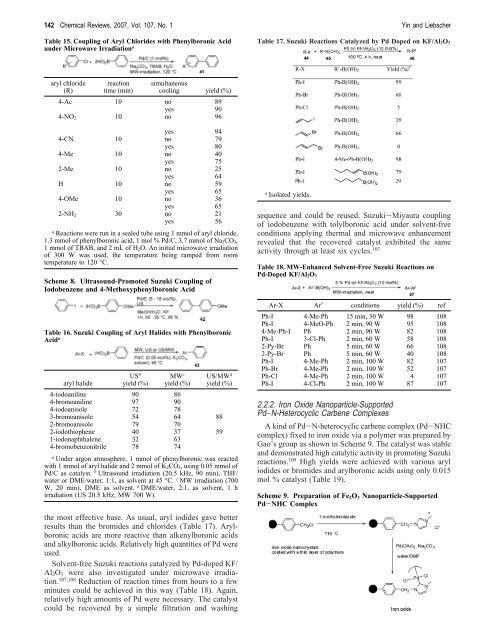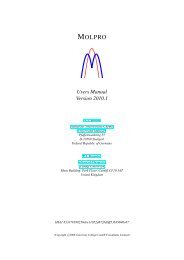Carbon−Carbon Coupling Reactions Catalyzed by Heterogeneous ...
Carbon−Carbon Coupling Reactions Catalyzed by Heterogeneous ...
Carbon−Carbon Coupling Reactions Catalyzed by Heterogeneous ...
You also want an ePaper? Increase the reach of your titles
YUMPU automatically turns print PDFs into web optimized ePapers that Google loves.
142 Chemical Reviews, 2007, Vol. 107, No. 1 Yin and Liebscher<br />
Table 15. <strong>Coupling</strong> of Aryl Chlorides with Phenylboronic Acid<br />
under Microwave Irradiation a<br />
aryl chloride<br />
(R)<br />
reaction<br />
time (min)<br />
simultaneous<br />
cooling yield (%)<br />
4-Ac 10 no 89<br />
yes 90<br />
4-NO2 10 no 96<br />
yes 94<br />
4-CN 10 no 79<br />
yes 80<br />
4-Me 10 no 40<br />
yes 75<br />
2-Me 10 no 25<br />
yes 64<br />
H 10 no 59<br />
yes 65<br />
4-OMe 10 no 36<br />
yes 65<br />
2-NH2 30 no 21<br />
yes 56<br />
a <strong>Reactions</strong> were run in a sealed tube using 1 mmol of aryl chloride,<br />
1.3 mmol of phenylboronic acid, 1 mol % Pd/C, 3.7 mmol of Na2CO3,<br />
1 mmol of TBAB, and 2 mL of H2O. An initial microwave irradiation<br />
of 300 W was used, the temperature being ramped from room<br />
temperature to 120 °C.<br />
Scheme 8. Ultrasound-Promoted Suzuki <strong>Coupling</strong> of<br />
Iodobenzene and 4-Methoxyphenylboronic Acid<br />
Table 16. Suzuki <strong>Coupling</strong> of Aryl Halides with Phenylboronic<br />
Acid a<br />
aryl halide<br />
US b<br />
yield (%)<br />
MW c<br />
yield (%)<br />
US/MW d<br />
yield (%)<br />
4-iodoaniline 90 86<br />
4-bromoaniline 97 90<br />
4-iodoanisole 72 78<br />
3-bromoanisole 54 64 88<br />
2-bromoanisole 79 70<br />
2-iodothiophene 40 37 59<br />
1-iodonaphthalene 32 63<br />
4-bromobenzonitrile 78 74<br />
a Under argon atmosphere, 1 mmol of phenylboronic was reacted<br />
with 1 mmol of aryl halide and 2 mmol of K2CO3, using 0.05 mmol of<br />
Pd/C as catalyst. b Ultrasound irradiation (20.5 kHz, 90 min), THF/<br />
water or DME/water, 1:1, as solvent at 45 °C. c MW irradiation (700<br />
W, 20 min), DME as solvent. d DME/water, 2:1, as solvent, 1 h<br />
irradiation (US 20.5 kHz, MW 700 W).<br />
the most effective base. As usual, aryl iodides gave better<br />
results than the bromides and chlorides (Table 17). Arylboronic<br />
acids are more reactive than alkenylboronic acids<br />
and alkylboronic acids. Relatively high quantities of Pd were<br />
used.<br />
Solvent-free Suzuki reactions catalyzed <strong>by</strong> Pd-doped KF/<br />
Al2O3 were also investigated under microwave irradiation.<br />
107,108 Reduction of reaction times from hours to a few<br />
minutes could be achieved in this way (Table 18). Again,<br />
relatively high amounts of Pd were necessary. The catalyst<br />
could be recovered <strong>by</strong> a simple filtration and washing<br />
Table 17. Suzuki <strong>Reactions</strong> <strong>Catalyzed</strong> <strong>by</strong> Pd Doped on KF/Al2O3<br />
a Isolated yields.<br />
sequence and could be reused. Suzuki-Miyaura coupling<br />
of iodobenzene with tolylboronic acid under solvent-free<br />
conditions applying thermal and microwave enhancement<br />
revealed that the recovered catalyst exhibited the same<br />
activity through at least six cycles. 107<br />
Table 18. MW-Enhanced Solvent-Free Suzuki <strong>Reactions</strong> on<br />
Pd-Doped KF/Al2O3<br />
Ar-X Ar′ conditions yield (%) ref<br />
Ph-I 4-Me-Ph 15 min, 30 W 98 108<br />
Ph-I 4-MeO-Ph 2 min, 90 W 95 108<br />
4-Me-Ph-I Ph 2 min, 90 W 82 108<br />
Ph-I 3-Cl-Ph 2 min, 60 W 58 108<br />
2-Py-Br Ph 5 min, 60 W 66 108<br />
2-Py-Br Ph 5 min, 60 W 40 108<br />
Ph-I 4-Me-Ph 2 min, 100 W 82 107<br />
Ph-Br 4-Me-Ph 2 min, 100 W 52 107<br />
Ph-Cl 4-Me-Ph 2 min, 100 W 4 107<br />
Ph-I 4-Cl-Ph 2 min, 100 W 87 107<br />
2.2.2. Iron Oxide Nanoparticle-Supported<br />
Pd−N-Heterocyclic Carbene Complexes<br />
A kind of Pd-N-heterocyclic carbene complex (Pd-NHC<br />
complex) fixed to iron oxide via a polymer was prepared <strong>by</strong><br />
Gao’s group as shown in Scheme 9. The catalyst was stable<br />
and demonstrated high catalytic activity in promoting Suzuki<br />
reactions. 109 High yields were achieved with various aryl<br />
iodides or bromides and arylboronic acids using only 0.015<br />
mol % catalyst (Table 19).<br />
Scheme 9. Preparation of Fe2O3 Nanoparticle-Supported<br />
Pd-NHC Complex












![Hetero [6+3] Cycloaddition of Fulvenes with N-Alkylidene Glycine ...](https://img.yumpu.com/35423358/1/190x245/hetero-6-3-cycloaddition-of-fulvenes-with-n-alkylidene-glycine-.jpg?quality=85)




